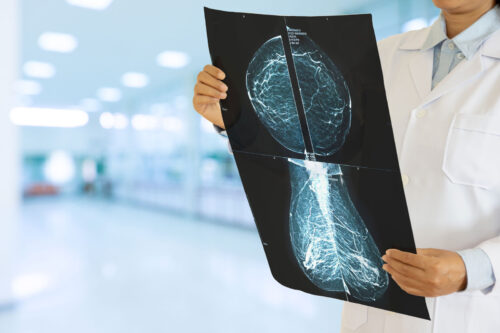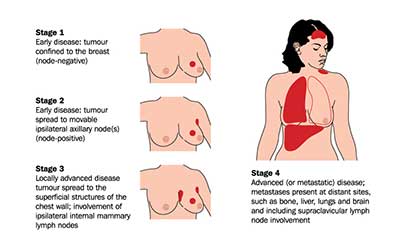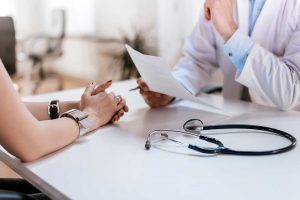Breast Cancer Screening
 Breast cancer screening is a thorough inspection for cancer. Breast cancer screenings aid in finding cancer at an early stage when it can be easier to treat. Generally by the time symptoms appear, cancer may have begun to spread making breast cancer more difficult to treat.
Breast cancer screening is a thorough inspection for cancer. Breast cancer screenings aid in finding cancer at an early stage when it can be easier to treat. Generally by the time symptoms appear, cancer may have begun to spread making breast cancer more difficult to treat.
BREAST CANCER FACTS
Here are a few facts about breast cancer:
- One in eight women in the United States will be diagnosed with breast cancer in her lifetime.
- Breast cancer is the most commonly diagnosed cancer in women.
- Breast cancer is the second leading cancer-caused death among women.
- Each year it is estimated that over 246,660 women in the United States will be diagnosed with breast cancer and more than 40,000 will die.
- Breast cancer occurs more often in white women than in black women.
- Black women are more likely than white women to die from breast cancer.
- Although breast cancer in men is rare, an estimated 2,600 men will be diagnosed with breast cancer and approximately 440 will die each year.
- On average, every 2 minutes a woman is diagnosed with breast cancer and 1 woman will die of breast cancer every 13 minutes.
- Over 2.8 million breast cancer survivors are alive in the United States today.
Sources: American Cancer Society and nationalbreastcancer.org
WHAT IS BREAST CANCER

Breast cancer is a disease in which malignant cancer cells begin to grow out of control and usually form a tumor in the tissues of the breast. The tumor is considered malignant or cancerous if the cells grow into the surrounding tissues and spread. When cancer spreads (metastasizes) into distant areas of the body, it can cause damage to vital areas of the body, become difficult to treat and can become fatal.
RISK FACTORS
The following are common risk factors in breast cancer:
- Getting older. The risk for breast cancer increases with age; most breast cancers are diagnosed after age 50.
- Genetic mutations. Inherited changes (mutations) to certain genes, such as BRCA1 and BRCA2. Women who have inherited these genetic changes are at higher risk of breast and ovarian cancer.
- Early menstrual period. Women who start their periods before age 12 are exposed to hormones longer, raising the risk for breast cancer by a small amount.
- Late or no pregnancy. Having the first pregnancy after age 30 and never having a full-term pregnancy can raise breast cancer risk.
- Starting menopause after age 55. Like starting one’s period early, being exposed to estrogen hormones for a longer time later in life also raises the risk of breast cancer.
- Not being physically active. Women who are not physically active have a higher risk of getting breast cancer.
- Being overweight or obese after menopause. Older women who are overweight or obese have a higher risk of getting breast cancer than those at a normal weight.
- Having dense breasts. Dense breasts have more connective tissue than fatty tissue, which can sometimes make it hard to see tumors on a mammogram. Women with dense breasts are more likely to get breast cancer.
- Using combination hormone therapy. Taking hormones to replace missing estrogen and progesterone in menopause for more than five years raises the risk for breast cancer. The hormones that have been shown to increase risk are estrogen and progestin when taken together.
- Taking oral contraceptives (birth control pills). Certain forms of oral contraceptive pills have been found to raise breast cancer risk.
- Personal history of breast cancer. Women who have had breast cancer are more likely to get breast cancer a second time.
- Personal history of certain non-cancerous breast diseases. Some non-cancerous breast diseases such as atypical hyperplasia or lobular carcinoma in situ are associated with a higher risk of getting breast cancer.
- Family history of breast cancer. A woman’s risk for breast cancer is higher if she has a mother, sister, or daughter (first-degree relative) or multiple family members on either her mother’s or father’s side of the family who have had breast cancer. Having a first-degree male relative with breast cancer also raises a woman’s risk.
- Previous treatment using radiation therapy. Women who had radiation therapy to the chest or breasts (like for treatment of Hodgkin’s lymphoma) before age 30 have a higher risk of getting breast cancer later in life.
- Women who took the drug diethylstilbestrol (DES), which was given to some pregnant women in the United States between 1940 and 1971 to prevent miscarriage, have a higher risk. Women whose mothers took DES while pregnant with them are also at risk.
- Drinking alcohol. Studies show that a woman’s risk for breast cancer increases with the more alcohol she drinks.
Source: Centers for Disease Control and Prevention
Women who have certain gene mutations, such as a BRCA 1 or BRCA2 mutation, have an increased risk for breast and ovarian cancer. If you have a family history of this please speak to your Rosemark provider about having genetic testing done.
SIGNS OF BREAST CANCER
Signs of breast cancer include:
- A lump or thickening in or near the breast or in the underarm area.
- Scaly, red, or swollen skin on the breast, areola or nipple.
- Dimples in the breast that look like the skin of an orange or the change of size or shape of the breast.
- Fluid, other than breast milk, from the nipple, especially if it’s bloody or a nipple turned inward into the breast.
- Nipple sensitivity.
- Itchy or painful breasts.
- Skin changes.
While these are the most common signs of breast cancer, it is not a comprehensive list as everyone’s body reacts differently. It is critical to pay attention to potential signs and if detected, contact Rosemark immediately for an appointment.
BREAST CANCER PREVENTION
A few breast cancer prevention steps include:
- Regular self- breast exams
- Yearly mammogram screenings beginning at the age of 40.
- Exercising regularly
- Eat healthy
- Avoiding cancer causing substances or activities, like smoking.
In some situations, patients may be prescribed medication to treat a precancerous condition or to keep cancer from starting. If a person has a genetic predisposition for breast cancer in their family, they may opt for risk reducing surgery to prevent from getting breast cancer.
BREAST CANCER SCREENING

The breast cancer screening process at Rosemark includes an investigation of the patient’s health history, family health history and review of any recent health care concerns. Any risk factors of breast cancer will be identified and explored. The healthcare provider will perform a physical examination of the breasts to look for any symptoms of breast cancer.
At the conclusion of the physical examination, the OB/GYN doctor or other healthcare provider may order laboratory tests, a breast biopsy, or a mammogram. Yearly mammogram screenings will likely be ordered for women 40 years of age or older.
SUMMARY
Breast cancer is a very serious disease in women and is something to be aware of and to look for in oneself. If you have a family history of breast cancer, feel lumps or see changes in your breasts, speak with your Rosemark ob/gyn doctor or other healthcare provider immediately about your concerns. Early detection saves lives!
